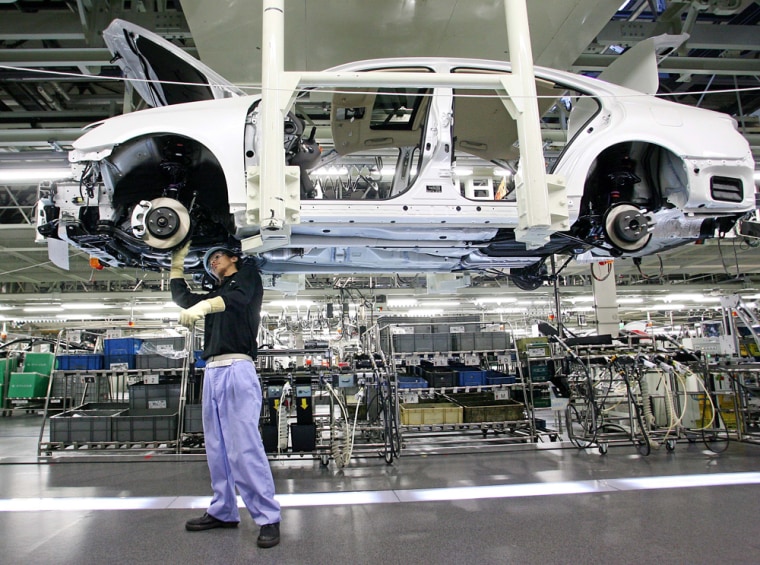Toyota Motor Corp. trounced the domestic automakers in the U.S. marketplace last month, posting a 25 percent year-over-year sales increase. General Motors Corp. and DaimlerChrysler AG each saw their sales slip by a few percentages points, while Ford Motor Co.’s sales gained 4.7 percent.
GM’s sales fell 3.1 percent last month, but the nation’s largest automaker put a positive spin on the decline, attributing it to a reduction in low-margin sales to rental companies. The company’s car sales fell 6.4 percent, while trucks, including pickups and sport utility vehicles, were down 0.7 percent. The numbers include the European Saab brand.
DaimlerChrysler said its overall decrease of 2.3 percent stemmed mostly from its U.S. subsidiary, Chrysler Group, where sales fell 3.8 percent. Sales of Mercedes-Benz vehicles rose 13.2 percent. The automaker was to release more detailed numbers later in the afternoon.
Ford’s increase over the same month last year was fueled largely by car sales, which rose 26.2 percent, while its truck sales fell 5.5 percent. The figures are for all Ford brands, including Jaguar, Volvo and Land Rover.
Toyota’s car sales rose 18.4 percent, while truck sales soared 34.9 percent, the Japanese automaker reported Tuesday.
“While crossovers, hybrids and small cars continue to show strength, our SUVs and full-size trucks also posted solid gains,” Jim Lentz, executive vice president of Toyota Motor Sales, said in a statement. “It’s the breadth of our lineup that enables us to satisfy today’s buyers.”
GM said its September sales were in line with expectations and predicted good results going forward, thanks to more fuel-efficient vehicles.
“Having products like the Chevrolet Cobalt, Malibu and newly redesigned 2007 Aveo in such high demand in the market place is gratifying,” Mark LaNeve, vice president for sales, service and marketing, said in a statement. “We will go even further for the 2007 model year by increasing the number of fuel-sipping vehicle models in the ‘30 mpg or Over Club’ by 9 vehicles, or more than 60 percent, to 23 models.”
Not a Ford turnaround
While the news was good for Ford, Tuesday’s numbers don’t necessarily signal a turnaround for the struggling automaker. Ford had relatively low sales in September 2005 following high summer sales fueled by deep discounts and a surge in September gas prices after Hurricane Katrina struck.
Ford said demand for its midsized cars, the Ford Fusion, Mercury Milan and Lincoln MKZ, and for the Mustang, remained strong and sales of the F-Series pickup and Explorer and Expedition sport utility vehicles all showed higher sales compared with September 2005.
The midsized cars were not offered in September of last year, and Mustang sales were up 31 percent, the company said.
Other Asian automakers reported mixed September sales, including Japan’s Nissan Motor Co., the sixth-largest player in the U.S. car market, which posted a sales drop of 9 percent on an adjusted basis, even as sales of its Titan pickup truck bounced back from recent lows.
Brad Bradshaw, North American sales chief for Nissan, said he expected sales of pickup trucks would steady on the back of cheaper gas prices, even though full-size SUVs remain weak.
“To me it says that there are some buyers out there that need to buy a pickup truck,” he said.
Honda Motor Co. said its U.S. sales in September were down 7.8 percent from a year earlier after adjusting for the number of sales days in the month.
Honda said that its truck sales rose 7.3 percent, but its passenger car sales dropped 16.4 percent in the month on an adjusted basis. For the first nine months of the year, the Honda’s U.S. sales were up 3.8 percent, the company said.
Analysts had forecast that overall U.S. auto sales would come in at an annual rate of about 16.6 million to 16.8 million units in September.
That would be up from 16.5 million in September 2005, a month when inventories were run down and sales had begun to taper off after a record-breaking summer fueled by employee-level discounts.
The U.S. auto market has been slowing since January, with sales off 4 percent through August, a trend attributed to a weaker housing market, higher interest rates and the earlier rise in gas prices.
Analysts had expected September sales to show a partial recovery for the segment of the market’s hardest hit amid the downturn: mid-size SUVs and full-size trucks.
After climbing above $3 per gallon over this summer, gas prices in the United States tumbled in September, dropping to near $2.30 on average, down about 16 percent over the month.
Both Chrysler and Ford also offered aggressive discounts on unsold 2006 model year trucks and sport utility vehicles in September to clear out inventory.
The downturn in the market for light trucks hit the traditional Big Three U.S. carmakers especially hard because those vehicles are more profitable for manufacturers than passenger cars, which typically sell for less.
In addition, the Detroit-based automakers rely on light trucks for well over half of their total U.S. sales. For GM, the amount is 60 percent, while at Ford it is 62 percent. For DaimlerChrysler the share is an industry-high 75 percent.
